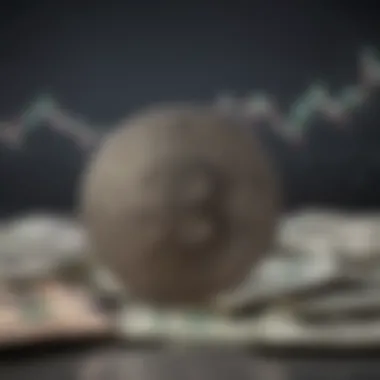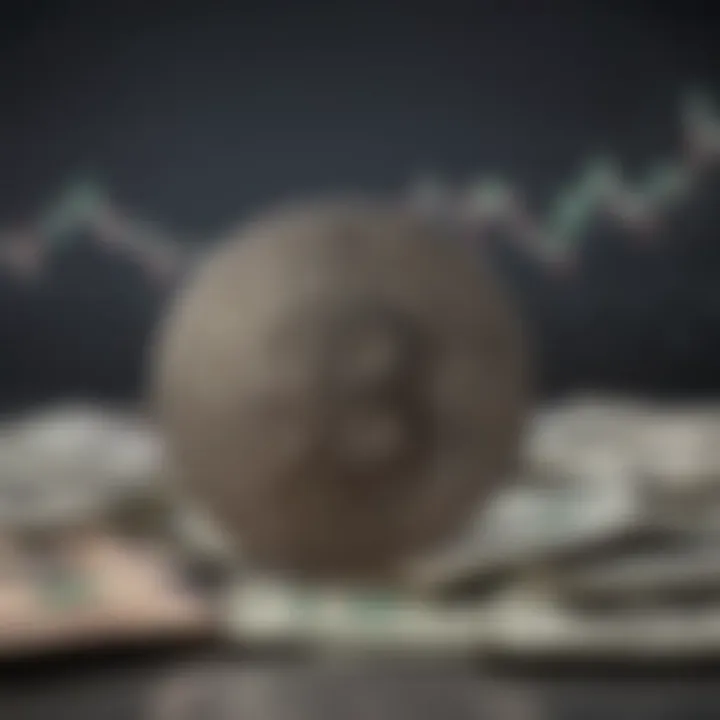Analyzing Dollar-Peso Exchange Rate Factors and Trends


Intro
In the world of finance, understanding currency dynamics is more crucial than ever. The relationship between the US dollar and the Philippine peso serves as a prime example of how global economic forces shape local markets. With a multitude of factors at play, from international trade flows to domestic policy changes, even seasoned investors find themselves grappling with the complexities of exchange rates. This narrative aims to provide a clear overview of these dynamics, drawing insights that can benefit both novice and experienced investors.
Many people often overlook how deeply currency fluctuations can affect their investment decisions. It's not just about numbers on a screen; it’s about the implications those numbers have for businesses, traders, and even consumers. As we dig deeper into this topic, we will explore historical trends, economic indicators, and strategies that can help you navigate this ever-shifting landscape.
With that said, let’s launch into the fundamental concepts that underpin this intriguing exchange.
Intro to Currency Exchange
Currency exchange holds a pivotal role in the intricate web of global finance. For investors and financial enthusiasts, understanding this concept is not just a matter of theoretical interest; it is a practical necessity. Fluctuations in exchange rates can affect everything from the price of imports and exports to the profitability of investments and the cost of traveling abroad. This article aims to shed light on the dynamics of currency exchange, particularly focusing on the interaction between the US dollar and the Philippine peso, which can serve as a bellwether for broader economic trends.
Understanding Currency Exchange
Currency exchange, simply put, is the process of converting one currency into another. This is not merely a matter of arbitrary numbers; these conversions reflect the economic health and stability of nations. When discussing currency exchange, it’s crucial to recognize that it operates on a floating system in many countries, meaning that exchange rates fluctuate based on supply and demand factors in the market. A myriad of elements influence these rates, including geopolitical events, economic indicators, and even the sentiment of financial markets.
"In today’s global economy, currency doesn’t just travel between borders; it carries stories of hope, fear, and change."
To truly understand currency exchange, one must delve into the underlying mechanisms that dictate these rates, such as interest rates, inflation, and political considerations. These factors combine to form a dynamic landscape where even small changes can lead to significant shifts, making it essential for investors to stay attuned to the latest trends and projections.
The Role of the Dollar in Global Economy
The US dollar stands as the world's dominant reserve currency, becoming an indispensable aspect of international trade and finance. When countries engage in global commerce, the dollar often serves as the intermediary currency, influencing various exchange rates, including that of the peso.
- Global Trade: As international transactions predominantly utilize the dollar, fluctuations in its value can have ripple effects across various economies, particularly in emerging markets like the Philippines.
- Financial Stability: The dollar is perceived as a safe haven, particularly during tumultuous times. Investors tend to flock to USD in times of uncertainty, which can lead to increased demand and, consequently, affect the dollar-peso exchange rate.
- Monetary Policy and Interest Rates: Decisions made by the US Federal Reserve can drastically influence the strength of the dollar. For instance, raising interest rates may increase investment in US assets, thus raising demand for the dollar and impacting its exchange rate against other currencies.
Recognizing the multifaceted role of the dollar helps clarify why movements in the dollar can portend changes in the peso's value. Investors need to contemplate these connections thoroughly to make informed decisions. Understanding the dollar's influence isn't just about watching numbers; it's about grasping the forces that shape economic relationships globally.
The Philippine Peso in Context
Understanding the role of the Philippine peso within the landscape of currency exchange is paramount for grasping the dynamics between the dollar and peso. The peso is not just a standalone currency; it's deeply intertwined with global financial shifts, national policies, and economic realities. As such, it serves as a good indicator of the overall economic health of the Philippines, while also being sensitive to external influences. Hence, in this section, we will delve into the historical and present-day significance of the peso, as well as its relationship with the global economy.
Historical Overview of the Peso
The historia of the Philippine peso is rich with metamorphoses that echo the country’s colonial legacies and economic developments. Much like its history, the peso has weathered numerous storms, adapting to the changing tides of commerce and governance. Its genesis can be traced back to the Spanish colonial period, when the peso fuerte became a standard medium of exchange. The transition to the modern peso came in 1903, introducing a more stable currency marked by the establishment of the Philippine Commonwealth.
Through the decades, the peso has faced its share of challenges, including the turbulence of World War II, shifts to independence post-colonial rule, and the political upheavals that followed. More recently, the peso has grappled with the realities of globalization and the Philippine economy's maturation, serving both as a reminder of its storied past while anchoring the future.
The peso's value over time has reflected the nation’s socio-political climate, with significant highs and lows marking various economic policies and external crises. Notably:
- In the late 1990s, the Asian financial crisis sent the peso tumbling, highlighting its vulnerability to external shocks.
- The global financial crisis of 2008 also left its markers, as investors sought safer havens, contributing to fluctuations in the peso’s strength.
Understanding these historical milestones enables investors to contextualize the peso’s current value and potential risks, making them better equipped for informed decision-making in currency exchanges.
The Peso's Alignment with Global Markets
In today’s economy, the peso does not operate in isolation; it dances in a bustling marketplace alongside various other currencies. This alignment with global markets is influenced by several factors, chief among them being bilateral trade agreements, foreign direct investments, and the overall health of the world's major economies.
For instance, the performance of the U.S. dollar has a dramatic ripple effect on the peso. When the dollar strengthens, the peso usually weakens, reflecting changing investor confidence and comparative economic indicators. Conversely, when the dollar slides, the peso often benefits, attracting capital inflows and facilitating exports.
Key relationship factors influencing the peso include:
- Trade Relations: As a major exporter of goods, any shifts in demand from the U.S. or other major markets directly affect the peso's strength.
- Investment Climate: Economic policies that create a favorable environment for foreign investments often lead to strengthening the peso, as investors seek to capitalize on economic growth potential.
- Remittances: A substantial share of the Philippine economy relies on remittances from overseas workers, and those inflows help stabilize the peso.
In essence, the peso acts as a barometer of investor sentiment, influenced by global developments and changing economic landscapes. Understanding this alignment helps investors anticipate shifts in the dollar-peso exchange rate, leveraging potential avenues for profit while mitigating risks.
Mechanics of Currency Exchange Rates
Understanding the intricacies of currency exchange rates is a fundamental aspect for anyone seeking to decode the relationship between the US dollar and the Philippine peso. The mechanics of currency exchange rates embody a combination of various elements that jointly dictate how one currency is valued relative to another. This is essential knowledge not just for financial enthusiasts but also for individual investors who want to navigate the complexities of global markets effectively.
There are several factors at play when it comes to understanding exchange rates. Grasping their mechanics allows investors to make informed decisions, manage risks, and optimize their investment strategies. As we traverse this landscape, it is pivotal to consider how and why these rates fluctuate over time and the various underlying currents that influence this volatility.
Factors Influencing Exchange Rates


The fluctuations in exchange rates don’t occur in a vacuum. They are shaped by a myriad of factors, including:
- Interest Rates: Central banks adjust interest rates to control monetary policy. Higher rates generally attract foreign capital, increasing the value of a currency.
- Economic Indicators: Inflation rates, employment numbers, and GDP growth can signal to investors the overall health of a country's economy.
- Political Stability: Countries with less risk for political turmoil tend to attract more foreign investment, positively impacting their currency value.
- Market Sentiment: The collective perception of traders and investors about future movements can sway exchange rates significantly.
- Government Debt: Countries with large debts are less attractive to foreign investors due to the risk of inflation and default, leading to depreciation in the currency’s value.
These elements create a dynamic environment where currencies, like the US dollar and Philippine peso, are constantly being evaluated in light of changing information and market conditions.
Demand and Supply Dynamics
The principles of demand and supply are fundamental to understanding currency movements. Just as with any commodity, the value of a currency is dependent on how much of it is being bought or sold in the market. A high demand for the dollar over the peso will push the exchange rate up, while an increased supply of the peso relative to the dollar will likely lower its value.
When investors or traders anticipate certain economic trends, this can lead to shifts in currency demand. For example, if the Philippine government announces initiatives that are expected to drive economic growth, demand for the peso may rise as investors buy pesos in anticipation of future valuation increases.
Additionally, factors such as tourism, remittances from overseas Filipino workers, and imports and exports play crucial roles in the demand and supply equation:
- Tourism: Increased tourism to the Philippines raises demand for pesos as foreigners exchange dollars.
- Remittances: Many Filipinos working abroad send money back home, increasing the demand for pesos.
- Exports and Imports: A growing export market can strengthen the peso as foreign buyers need local currency to purchase goods.
All of these dynamics come together to create a constantly shifting landscape in the world of currency exchange. Awareness of these factors is vital for those engaging in currency trading or considering investments impacted by exchange rate fluctuations.
"A fundamental understanding of the demand and supply mechanics can be a game changer for investors looking to profit from currency fluctuations."
By comprehending how these elements interlock, investors can better position themselves to navigate the often turbulent waters of foreign exchange markets, making sound decisions grounded in a thorough understanding of the underlying mechanics.
Recent Trends in Dollar to Peso Exchange
Understanding the recent trends in dollar to peso exchanges sets the tone for grasping the intricate relationship between the two currencies. This section sheds light on the factors impacting the exchange rates recently, allowing investors to make informed decisions based on current and predictive data. Examining these trends offers insights into macreconomic conditions, investment strategies, and market sentiment. Currency fluctuations can have a direct impact on both international trade and individual financial decisions, making this analysis particularly relevant to discerning investors.
Analysis of Exchange Rate Fluctuations
Exchange rate fluctuations between the dollar and peso reveal patterns driven by various elements. For instance, both economic stability and inflation rates play crucial roles. When the US experiences economic growth or higher interest rates, the dollar often strengthens against the peso. Conversely, uncertainties in the Philippine economy can lead to a depreciation of the peso. Labeling these fluctuations is not merely about observing upswings and downturns; the context surrounding such changes often highlights deeper economic narratives.
Take a moment to consider the political events impacting both nations; they often intersect at critical junctures. After natural disasters or political instability in the Philippines, for example, the peso's value may slide downward as confidence diminishes. Meanwhile, robust employment data from the U.S. can bolsterthe dollar's strength as investors flock to perceived safe havens. To put it another way:
"Exchange rates are like a reflection of the mood in both countries. When one is feeling good, the other might be under the weather."
Recent statistics indicate a fluctuating pattern with notable spikes during regional trade discussions or global economic shifts. Investors are advised to keep a keen eye on these fluctuations, as they can provide strategic entry and exit points.
Impact of Economic Policies
Economic policies implemented by both the United States and the Philippines significantly influence the dollar-peso exchange rate. The Federal Reserve’s monetary decisions, for instance, carry weighty repercussions for currency values. If the Fed raises interest rates, this attracts foreign capital into dollar-denominated assets, causing a jump in the dollar's strength compared to the peso.
On the flip side, the Bangko Sentral ng Pilipinas (BSP) also plays its part. Its responses to inflation and economic performance can help stabilize or destabilize the peso. For instance, if the BSP decides to cut rates to stimulate growth, the peso may weaken as the dollar gains favor. Investors should therefore keep an eye on statements from both central banks, as these often hold important clues.
Another factor worth mentioning is fiscal policy. Funding for infrastructure projects or changes in taxation can sway investor sentiment. If Philippine government initiatives appear solid, it could lead to a stronger peso. However, if policies are perceived as ineffectual, it could spell trouble for the local currency. Ultimately, understanding how economic policies impact exchange rates helps investors mitigate risk and harness potential financial opportunities in the dynamic dollar-peso landscape.
Investing in Currency Exchange
The world of currency exchange is a complex yet essential aspect of the global financial landscape. Investing in currency exchange sets the stage for potential peculiarities that might come about from fluctuations in exchange rates. With the dollar to peso dynamic being an ever-changing canvas, understanding this space is crucial for both seasoned investors and newcomers alike.
Investing in currency exchange can indeed be lucrative but it requires a keen eye on various factors that influence the market. One major element is the economic stability of the countries involved. When the Philippine economy shows signs of growth, for instance, demand for the peso might rise, subsequently impacting the exchange rate favorably for those holding pesos. Conversely, any hint of instability or unfavorable policies can send the peso tumbling.
Considerations for Successful Currency Investment
There are several considerations before diving into currency exchange as an investment strategy:
- Market Sentiment: Keeping track of news and social media can provide insights into how the market might react.
- Political Factors: Elections, legislation, and other political events can create ripples in currency values.
- Economic Indicators: GDP growth, employment rates, and inflation are essential factors to consider.
Strategies for Currency Conversion
When navigating the waters of currency conversion, having a strategy is like plotting a course through a storm. Investors must first ascertain their risk tolerance. Using a hedging strategy is one of the most prudent methods to manage risks. For example, purchasing options might allow an investor to lock in an exchange rate, thus providing a safety net against unfavorable fluctuations.
Other strategies that may be useful include:
- Timing the Market: Watching the trends over time to recognize patterns in the dollar-peso exchange rate.
- Using Currency ETFs: Exchange-traded funds allow for diversified exposure without direct involvement in trading currencies.
- Engaging with Forex Brokers: Leveraging brokers with expertise can help navigate the nuances in the market effectively.
Investing in currency exchange doesn't just happen overnight. It demands both patience and fortitude.


When to Convert Dollars to Pesos
Understanding the optimal timing for currency conversion can significantly impact potential gains. Generally, converting dollars to pesos could be beneficial when the exchange rate appears advantageous. Investors should pay attention to seasonal trends; for instance, periods of increased tourism in the Philippines can lead to a stronger peso, which lowers the dollar's value in comparison.
Additionally, keeping an ear to the ground regarding economic news is essential. Announcements surrounding interest rate changes, inflation reports, or fiscal policies can serve as indicators for when to make the switch. Following international financial forums such as reddit or financial news websites provides a constant stream of updates.
The Role of Central Banks
When it comes to understanding the currency exchange between the dollar and the peso, central banks hold the reins. Their significance isn’t just an afterthought but is rooted deeply in the very mechanics of how these currencies interact in the world market. Central banks, such as the Bangko Sentral ng Pilipinas (BSP) and the Federal Reserve, play crucial roles in shaping currency values through their monetary policies and interventions. These institutions focus primarily on controlling inflation, stabilizing the currency, and fostering economic growth.
Monetary Policy and Its Effects
Monetary policy is akin to a ship navigator, guiding the economy’s course. Central banks utilize this tool to influence interest rates and regulate the money supply, directly impacting exchange rates. In practice, when a central bank decides to lower interest rates, borrowing becomes easier, fueling spending and investment by consumers and businesses. This infusion of funds can stimulate an economy but, on the flip side, could lead to inflation if the money supply expands too rapidly.
Consider the recent actions of the Federal Reserve.
- An increase in interest rates usually strengthens the dollar against the peso, as higher returns on investments lure foreign capital.
- Conversely, if the BSP adopts a loose monetary policy to stimulate growth, it might lead to a depreciation of the peso.
The interplay of these policies not only affects trade balances but also international investment flows. A savvy investor needs to keep their ear to the ground regarding these central bank decisions to assess future movements of the dollar-peso exchange rate effectively.
Central Bank Interventions
Interventions by central banks can be direct or indirect. Think of it as a chess game where central banks make calculated moves to either stabilize or influence their currency's value.
- Direct Intervention: This happens when a central bank buys or sells its currency in the foreign exchange market to influence its value. For instance, if the peso weakens too much, the BSP might step in, purchasing pesos with dollars to support its value.
- Indirect Intervention: More subtly, a central bank might influence exchange rates through policy announcements. For example, any indications of a possible interest rate hike can lead to immediate changes in the currency market, as investors act on perceived future returns.
"Central banks are akin to gatekeepers of economic health. Their policies ripple through various sectors, redefining potential risks and rewards in currency markets."
Understanding these interventions and policies can empower investors and individuals alike to anticipate potential shifts in the dollar-peso exchange rate. By several accounts, these dynamics underscore the intricate dance between political decisions and economic realities, a performance that savvy financial enthusiasts must follow closely.
Future Projections for the Dollar-Peso Exchange
Examining the future projections for the dollar-peso exchange rate serves as a crucial component of understanding this dynamic relationship between the US dollar and the Philippine peso. Given the fluctuating nature of exchange rates, various elements will significantly impact their trajectory. Investors need to grasp these projected trends to make informed decisions about their currency conversions and investment strategies.
Knowledge of future projections will help investors identify potential opportunities or risks in the currency market. By understanding these movements, stakeholders can better position themselves whether through immediate conversions or long-term investments.
As such, this section will delve into economic indicators to monitor, potential risks involved, and opportunities that may arise from shifts in the dollar to peso exchange dynamics.
Economic Indicators to Watch
Keeping track of economic indicators is vital for anticipating how the dollar-peso exchange rate may move in the near future. Some key indicators to keep an eye on include:
- Inflation Rates: Higher inflation in the Philippines relative to the US can weaken the peso against the dollar. It’s essential to analyze both countries' inflation reports.
- Interest Rates: Changes in interest rates set by the Federal Reserve or the Bangko Sentral ng Pilipinas will impact currency valuations. Typically, higher interest rates in a country attract foreign investments, leading to a stronger currency.
- Gross Domestic Product (GDP) Growth: The GDP reflects the economic health of a nation. Solid economic performance generally boosts confidence in the local currency.
- Balance of Trade: Analyzing exports and imports can provide insights. A trade deficit could weaken the peso while a surplus may strengthen it.
- Political Stability: Geopolitical tensions around the world can influence exchange rates. Political stability usually favors a stronger currency as investor confidence increases.
"Economic indicators are the breadcrumbs leading us through the forest of currency exchange. Tracking them is crucial for navigating volatility."
Potential Risks and Opportunities
While monitoring these economic indicators, it's also important to understand the potential risks and opportunities that could shape the future of the dollar-peso exchange.
Risks include:
- Global Economic Slowdown: If major economies slow down, it can lead to reduced demand for exports, which might negatively impact the peso.
- Natural Disasters: The Philippines is prone to typhoons and earthquakes, which can cause extensive economic damage and volatility in the currency.
- Political Instability: Sudden shifts in government or policies can provoke uncertainty, leading to currency depreciation.
On the other hand, potential opportunities can emerge from:
- Investments in Infrastructure: Various government initiatives aiming to improve infrastructure can bolster economic growth, enhancing peso strength.
- Tech Industry Growth: As start-ups and tech companies flourish, the demand for pesos could increase. This, in turn, impacts the exchange rate positively.
- Strong Tourism Recovery: A rebound in tourism, an essential sector for the Philippine economy, can lead to stronger peso performance against the dollar.
Ultimately, staying abreast of these indicators, risks, and opportunities allows for a more nuanced approach to currency transactions. A well-informed investor can harness these insights to navigate the complexities of the dollar-peso exchange landscape.
Impact of Global Events
Global events significantly shape the economic landscape, influencing currency values and affecting exchange rates. Understanding these dynamics is critical, especially for those involved in foreign exchange markets or international investments. The dollar to peso exchange rate is particularly sensitive to a myriad of global occurrences that range from geopolitical tensions to economic crises. Since no currency exists in a vacuum, the interconnectedness of the global economy means that shifts in one region can propagate changes across other markets.


In exploring the impact of such events, one can identify several key elements to consider:
- Geopolitical Stability: Political unrest or changes can lead to fluctuations in currency strength. Investors often respond to perceived risks by shifting investments to safer assets, like the US dollar, which can inflate its value against the peso.
- Trade Agreements: International trade policies directly affect currency exchange rates. When countries restructure trade agreements, it can enhance or weaken economic relations, thereby impacting the flow of dollars and pesos between nations.
- Market Reactions: Global events often trigger immediate reactions in the financial markets, leading to sudden and dramatic movements in exchange rates. These momentary fluctuations may not always align with fundamental economic indicators, creating opportunities and risks for investors.
By keeping an eye on global developments, individuals can better predict trends in exchange rates and make more informed investment decisions.
Geopolitical Factors
Geopolitical events can be a major catalyst in the dollar to peso exchange dynamics. Events such as foreign policy changes, military conflicts, or diplomatic relations all contribute to the environment in which currencies operate. For instance, a political crisis in the Philippines could incite fears of instability, prompting capital flight from the peso to the dollar. Consequentially, this creates upward pressure on the dollar while causing the peso to slump.
Moreover, in this age of information, market sentiments can shift based on speculative analyses of potential geopolitical risks. Increased tension between nations, particularly those involved in trade with the Philippines or the United States, will usually influence currency values. The market's perception of these tensions is often just as critical as the underlying realities.
Despite the chaos that geopolitical factors can introduce, understanding these events allows investors to strategize accordingly.
Pandemic Influence on Exchange Rates
The COVID-19 pandemic accentuated global interdependencies and highlighted the profound impact of health crises on economies. Early in the pandemic, there was a massive flight to safety, where investors flocked to the resilient US dollar, driving its value up and significantly affecting the dollar to peso exchange rate. The pandemic's disruptions unearthed vulnerabilities in various economies, especially in developing nations like the Philippines.
In addition, economic forecasts were affected due to heightened uncertainty, driving volatility in exchange rates. The Philippines, reliant on remittances from overseas workers, witnessed a fluctuation in peso value as global job losses unfolded. As remittances dipped, so did demand for pesos,
Furthermore, navigating through the pandemic recovery phases, shifts in policy like stimulus packages and welfare measures also influenced currency valuations. The dollar's bolstered performance during these phases can often be attributed to aggressive monetary policies by the U.S. Federal Reserve compared to the Philippines' responses.
Ultimately, both geopolitical factors and pandemic influences serve as potent reminders of how global events shape market sentiments and currency values, emphasizing the need for investors to remain vigilant and informed.
Practical Implications for Investors
When wandering through the intricate world of currency exchange, the dollar to peso dynamics emerges not just as mere numbers, but a symphony of economic forces that can impact investments. Understanding this relationship is crucial for investors, especially those who dabble in foreign currencies. Ignoring these implications can be akin to sailing without a compass, leading to unforeseen pitfalls.
One primary aspect revolves around exchange rate risks. In financial markets, fluctuations present both opportunities and challenges. When the dollar appreciates against the peso, it can erode the potential gains from investments made in the Philippines. Conversely, if the peso strengthens, returns in USD may diminish. Keeping a wary eye on the exchange rate can illuminate the path to making informed decisions.
"Currency exchange is not just a convenience; it is a reality that touches every aspect of global finance."
In addition to exchange rate risks, investors must also consider their investment horizon. Currency dynamics reflect broader economic trends, such as inflation rates, interest rates, and geopolitical stability. A long-term approach might allow investors to ride out short-term volatility while still reaping potential rewards. Keeping abreast of these factors can mean the difference between a fruitful venture and a financial misstep.
Understanding Exchange Rate Risks
Exchange rate risks represent the threat that foreign currency investments may lose value as exchange rates fluctuate. For those looking to invest in assets priced in Philippine pesos, a sharp rise in the dollar could push down the value of their returns when converted back into USD. Conversely, should the peso gain strength, returns on investments could greatly increase when exchanged.
To grasp this risk better, it's important to acknowledge specific factors that can influence exchange rates:
- Economic Indicators: Inflation rates, GDP growth, and employment figures play a crucial role. A shaky economy may weaken the peso.
- Monetary Policy: Decisions made by central banks can either stabilize or disrupt exchange rates. For instance, if the Central Bank of the Philippines raises interest rates, it could bolster the peso against the dollar.
- Political Stability: Political unrest often sends investors running for safer currencies, notably the dollar. A stable political environment in the Philippines is likely to attract foreign investors, strengthening the peso.
Long-Term Investment Considerations
Approaching investment with a long-term perspective can offer immense benefits, particularly in the context of currency exchange. Historical trends indicate that while volatility exists in the short term, currencies often revert to a mean over the period. This insight allows for a more strategic placement of capital.
Here are some considerations for investors eyeing long-term strategies:
- Diversification: Spread risk across various asset classes—stocks, bonds, and real estate in both local currency and USD. This could mitigate potential losses stemming from dollar-peso fluctuations.
- Monitoring Factors: Keep an eye on both local economic conditions and global economic climate changes. For instance, changes in the US Federal Reserve's policy can have a ripple effect on the peso.
- Hedging Strategies: Employing options or futures can provide a safety net, allowing investors to lock in exchange rates and limit potential losses.
Epilogue
The conclusion acts as the final puzzle piece in the intricate mosaic of dollar-peso exchange dynamics. It synthesizes the various threads woven throughout the article, reinforcing the significance of understanding how these currencies interact. Grasping this relationship not only benefits investors but also anyone engaged in the global market or planning travel to the Philippines. In this constantly moving landscape, recognizing shifts in exchange rates can be just as vital as understanding local economic indicators.
Summarizing Key Insights
In summary, this exploration has revealed several key insights:
- Historical Context Matters: The peso's journey, shaped by historical events, economic policies, and global markets, provides a rich backdrop for understanding the current exchange rates.
- Factors at Play: Elements like inflation, interest rates, and geopolitical events continually influence the dollar-peso dynamic, making it crucial to keep an eye on these indicators for investment planning.
- Investing Strategies: Investors can benefit considerably by aligning their strategies with the analytical insights from the fluctuations in exchange rates, particularly during more volatile periods.
A well-informed investor can maneuver better in this sphere, leveraging knowledge to maximize returns or minimize potential losses.
Final Thoughts on Dollar-Peso Dynamics
In wrapping up, the dollar-peso exchange dynamics embody much more than merely numeric figures on a trading screen. They reflect the heartbeat of economic realities in two distinct regions—the US and the Philippines. As the world heads deeper into a globalized economy, the implications of these currencies will only grow in importance. Each shift in exchange rate is akin to a heartbeat, echoing the broader economic conditions and potential future pathways. Investors and ordinary individuals alike should pay heed, not just for immediate financial advantage, but for a deeper understanding of global interconnections.
"In the tapestry of global finance, the thread of currency exchange is woven tightly with economic foresight. Awareness opens doors—and investing in knowledge is the best currency of all."
By being mindful of these dynamics, one positions themselves squarely in the path of opportunity, ready to take action based on informed decisions.













